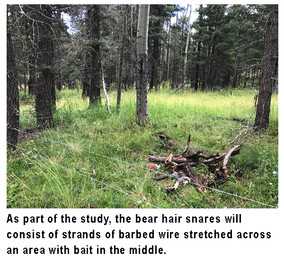New Mexico Department of Game and Fish
Public contact, Information Center: (888) 248-6866
Media contact, Tristanna Bickford: (505) 476-8027
tristanna.bickford@state.nm.us
FOR IMMEDIATE RELEASE, JUNE 12, 2020:
Department expands black bear population estimate survey into the Gila National Forest
SANTA FE – During the summer of 2020, Department biologists and conservation officers will be starting a two-year black bear population estimate study using hair snares in the Gila National Forest.

Bear hair snares are a modern study technique designed to collect DNA and allow biologists to identify the number of bears in an area. Starting in early June, Department biologists and conservation officers will set up the hair snares across the Gila National Forest. The hair snares will consist of strands of barbed wire stretched across an area with bait in the middle. As bears duck under or step over the wire a small amount of hair will be collected.
Elise Goldstein, assistant chief of wildlife for the Department said “the DNA collected will help biologists continue to make informed wildlife management decisions, ensuring that New Mexico continues to have a healthy, robust population of bears.”
Summer is the ideal time for these DNA samples to be collected; bears are shedding their winter coats and the snare will pull this loose hair without harming the bear. The study occurs during breeding season when bears are moving more. Biologists will collect the hair, which will then be sent for DNA analysis at an internationally recognized lab utilized by many state agencies and universities for their wildlife genetic studies.
Bear hair snare sites are not located in high use areas, but if you are recreating in the Gila National Forest and find one of these sites, the Department asks you to not touch the study areas and to make your way around the sites.
In the past several years similar studies have been completed in the northern and southern Sangre de Cristo Mountains, Sandia Mountains and the northern and southern Sacramento Mountains. Learn more about these studies in this report. The Department also recently wrapped up a bear hair study in the Jemez Mountains.
###

